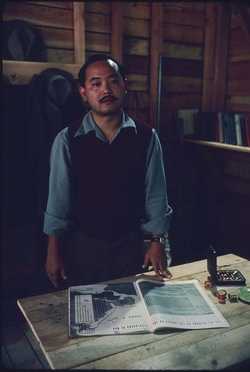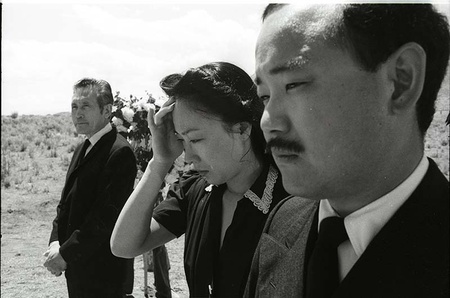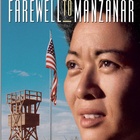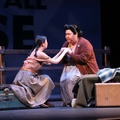Farewell to Manzanar, adapted from the memoir that Jeanne Wakatsuki Houston penned with her husband, James D. Houston, tells the story of the injustice suffered by 120,000 Japanese Americans during World War II by focusing on a single family, the Wakatsukis, as seen through the eyes of seven year old Jeanne. It was directed by Oscar and Emmy award winning director, John Korty, and featured an almost entirely Japanese American cast and crew.
Farewell to Manzanar had a profound impact on viewers when it was originally telecast on NBC in 1976 but the movie also had lasting effects on the actors. Sadly, thirty-five years later, a number of the principal performers, including Yuki Shimoda, Nobu McCarthy, Pat Morita, and Mako, have passed away. However, three actors who played very prominent roles in the movie—Clyde Kusatsu, Momo Yashima, and Akemi Kikumura Yano—were guests at the Japanese American National Museum’s screening of the film which is now available for the first time on DVD. They recently shared memories of their experiences on the set and how it affected their careers.
Clyde Kusatsu, who played eldest son Teddy Wakatsuki, is one of the most recognizable faces on stage and screen today. With hundreds of television and movie credits, it’s hard to name a popular television series that he hasn’t appeared on—from All in the Family, M.A.S.H., and Magnum, P.I. to more recent hits like ER, NCIS, and Law & Order, L.A., to name just a small sampling. The Hawaii-born actor’s career spans appearances in both the original Hawaii Five-0 in the ‘70s and again in this year’s version. And while older moviegoers might remember him in the big screen feature, Midway, younger audiences know him as Harold’s father in Harold & Kumar II.
“I’d always wanted to be an actor,” said Kusatsu. He learned his craft at Northwestern University’s theater department, playing everything from light comedies to Greek tragedies—non-Asian roles, all—but when he moved to California after graduation, he remembered that “you could count the Asian actors in Hollywood on both hands and the roles being offered were not especially enriching or engaging.” Kusatsu was a member of East West Players, an Asian American theater company, when he heard that a movie based on Farewell to Manzanar was in the works. He read the book, auditioned and won the role of Teddy.
Kusatsu said some members of the Japanese American community opposed the project out of concern that the movie was going to be a sell-out. “I think it also had to do with the cultural aspect. The Asian culture is ‘don’t show any emotion.’ To show any emotion is shame, bringing attention to us all, and the question of your giri, your gaman, your endurance. People worried,” he continued, “that the film wouldn’t get to the nitty gritty but it’s not about that. Actually, it’s about a family’s story and that’s why it has universal appeal.” Just as the mini-series Roots, so effectively allowed viewers to identify with African American families, Kusatsu believed that “with the right vehicle, you could do more with less.” Farewell to Manzanar was that vehicle.
Kusatsu described how choice shaped his performance. “That’s what acting is, making choices,” he said, “like when to express your opinion or your emotions about a thing.” While he believes that, as an actor, “the less you do, the more you say,” he also knows the importance of choosing your moment to make the most of an opportunity. “I didn’t know if I was ever going to be cast in that kind of a role again, kind of a steady guy, married, the oldest son, kind of a lead type of person.” Hollywood films typically portrayed Asian actresses as “exotic” and sensual while Asian males, rendered emotionless, were denied romantic scenes. So when the script called for Teddy and his brother Richard to wave goodbye to their family as they boarded a bus from camp to join the Army, Kusatsu took his opportunity. “We had the goodbye scene and I just kissed Akemi (Kikumura who played his wife, Chiyoko). It was not just a chaste kind of kiss, not to go into detail, but it was great way of enhancing the scene. At a certain point, I heard John (Korty) calling ‘cut...cut...CUT!’ and it was funny but I felt good about it because it was an opportunity to show a human side.” The film, Kusatsu notes, “still holds up and what holds up is that common humanity.”
“It’s not very often that something like Farewell to Manzanar comes along,” Momo Yashima maintains. She played the rebellious teenaged daughter Alice in the film.
Yashima, a native New Yorker, was an English major, dance minor at USC/University of California at Los Angeles when her brother, Mako, an Academy Award winning actor and co-founder of East West Players, asked her to help the actors with movement and dance. “That’s how I got swept in,” said Yashima, “but I also stage managed, ran the lights, and did all kinds of backstage work before getting a real part on stage.” She joined a touring company associated with East West Players and gained experience in improvisation and experimental theater.
Solid preparation is central to Yashima’s approach to acting so for more training, she applied to the Neighborhood Playhouse School of Theater in New York and was accepted. “While I was in New York, I realized that the shows they were doing at that time had no place for Asian Americans so I came back to East West Players and did many more shows.” That marked the beginning of a long career as a professional actor, with numerous stage, television, and movie credits.
As always, Yashima prepared for her role by digging into research. Not satisfied with what was available on the World War II incarceration at that time, “I decided to interview the parents of my friends but I was appalled at them saying they had a great time. I wanted to hear about how bad it was and who stood up and who fought and why did they go? But instead, I was just told, ‘you don’t understand what it was like.’” And she didn’t. “You can read about it, you can hear about it, but until you see that barbed wire that’s preventing you from getting out, it’s an experience that I only could have had through being on location.”
Yashima recalled the camaraderie of the cast and gathering to watch the dailies—the raw footage shot each day—with director, John Korty, from whom she learned so much. But she also made her own contributions to the film by lobbying for the addition of a small but telling scene where Alice defies her mother’s wishes to join the family for dinner at the mess hall. The scene captured the disintegration of family customs and traditions caused by the upheaval of the incarceration. A rebellious teenager is someone everyone can relate to. Again, it’s the common humanity that’s so powerful in Farewell to Manzanar.
The emotions that so many former inmates tried to suppress, like anger, frustration, shame, or bewilderment were revealed through each member of the Wakatsuki family. “That’s why my fervor for this film was so great at the time,” says Yashima, “but it’s even greater now.” She’s finally answering those questions—who stood up? who resisted—that she had while researching the incarceration. “I’m about to finish my first documentary as writer, director, and producer,” said Yashima of her film, A Divided Community: Three Personal Stories of Resistance, which examines those who fought the forced removal and spent years in a federal penitentiary on draft evasion convictions. “I’d never done anything like this but I could see what I wanted in my head, capture it on film, and edit it. I think that ability came from watching the dailies with John.” Yashima hopes that her film, like Farewell to Manzanar, “will start people talking, getting their stories out, letting young people know what really happened.”
Remembering and preserving the history has been the lifelong work of another Farewell to Manazanar alum, Akemi Kikumura Yano, who played Teddy’s wife, Chiyoko. She has approached the task as an actress and as an academic. When Kikumura Yano answered the casting call for Farewell to Manzanar, she, too, was a member of East West Players while also a graduate student at UCLA, pursuing a Ph.D. in anthropology. Always interested in Japanese American history, community, and culture, Kikumura Yano put herself through school with the performing arts.
“For actors on a project of historical importance,” said Kikumura Yano, “you feel an extra push to get it right.” And because the movie was of such interest to the Japanese American community, “every step of the way, people were watching.” Among the extras working on the film were notable figures like Sue Embrey, founder of the Manzanar Pilgrimage; Frank Chin, author, playwright, and activist; and Lawson Inada, acclaimed writer and poet. They all had a stake in preserving that history for future generations.
Filming on location had additional significance for Kikumura Yano. “The main locale for Farewell to Manzanar was Tule Lake because it was still relatively intact,” she explained. “My husband, who was not yet my husband, went with me on the set. He rode around and actually found where he was born because the barack was still standing.” She added, “that show really made an impact on me for the rest of my life.”
On the set, Kikumura Yano made friendships that lasted a lifetime, like her dear friend, the late Nobu McCarthy. McCarthy had been a model and made her first Hollywood movie, Geisha Boy, with Jerry Lewis. “I remembered her as a very young girl and how beautiful she was. The funny part though was, on the set, playing Misa, the mother, she looked like an old lady. But at night, we’d go back to our hotel and she’d change into her own clothes and all the guys would ask, ‘Who is that?’ We just had a great time.”
Kikumura Yano described a controversy that developed over the ending of the film “where the father drives off into the sunset, breaking down a barrier. I know Sue Embrey and others in the Nisei community felt like it was a ‘happily ever after’ ending but looking at it so many years later, the ending seems very appropriate. The family went through a truly terrible time. The ending wasn’t happy but more about breaking loose, starting again.”
There was a great deal of pressure to get the story right. “I think the reason why there was so much at stake is because Farewell to Manzanar is only one story, and yet there are thousands of stories, 120,000 stories. Regrettably, thirty-five years later, nothing as accurate has been shown to the American public.”
Kikumura Yano has continued to work on recording, interpreting, and sharing those stories off-screen. She is an award winning author, has taught at UCLA, and spent more than twenty years working at the Japanese American National Museum, most recently serving as the Chief Executive Officer until July, 2011. “It’s important to tell the stories, the history, from the inside out,” said Kikumura Yano. “That’s what the museum does. It’s my personal mission to share stories with others—to keep, preserve, and never forget.”
Order the DVD from the Museum Store >>
© 2012 Esther Newman








